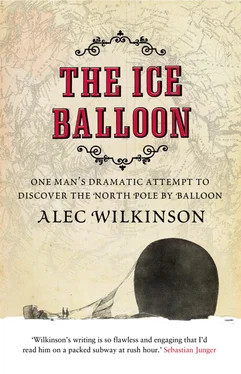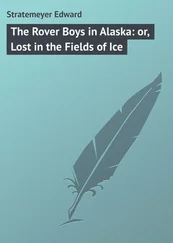If Andrée ever saw the letter, he didn’t mention it in his writings.
He never saw Wise again either. In September, five months after Wise had written to the Times, Andrée “read in the papers that my old friend had gone off on a balloon trip, had been caught in a storm and had never since been heard of.” Wise was lost on September 29, in the Pathfinder, over Lake Michigan. “For his sake I like to believe that he landed unhurt and that he thereafter encountered obstacles which prevented him from coming home,” Andrée wrote.
Andrée exemplified a conceit that outlived him—the belief, then nascent, that science, in the form of technology, could subdue the last obstacles to possession of the world’s territories, if not also its mysteries. More or less as psychologists were beginning to regard the deeper orders of the mind, this view saw nature as a shadowy chamber of secrets, a vault, that could be illuminated by the new instruments of science. Its banal applications were typified by devices for the home and the factory—the gramophone, the vacuum cleaner, the arc welding machine—that made life easier, and its sinister ones were the innovations in weapons—the machine gun, the torpedo—and their influence on the tactics of war. For all its worldliness it was also an innocent notion, a response to Romanticism, which had influenced earlier ideas about the Arctic.
Andrée might also be said to have believed in a sort of new dismissiveness that held that anything modern was more desirable than a lived-in idea or artifact. The balloon was superior to the sledge and the ship. The encumbrances of the ocean and the land were absent from the air. The sledge and the ship had failed, the balloon and the air were all possibility. He was the first explorer to head toward the pole unaccompanied by Romantic references.
A hallmark of the Romantic tradition was the notion of the “sublime,” described by Edmund Burke, in A Philosophical Enquiry, which was published in 1757. The sublime was characterized by an astonishment that drove from the mind all other feelings but terror and awe, Burke wrote. This stupefying dread was “the strongest emotion which the mind is capable of feeling.” The terror, which was encompassing and prevented reasoning or reflection, was provoked partly by an apprehension of the infinite, and also of the holy. The sublime aroused the deepest feelings the soul could embody, while simultaneously making someone aware that the object which inspired them was a component of a universe that was perhaps largely indifferent, if not unsympathetic, to his well-being both as an individual and a type. Man responded to the sublime because it was glorious—to feel the sublime was to scent the sacred—and because being fitted to feel powerfully, to be profoundly stirred, meant that something of the sublime reverberated within him, otherwise how could he recognize it.
The objects that inspired the sublime were “vast in their dimensions” and “solid, even massive,” Burke wrote. Mountains are what he had in mind, the type of towering, pointy, snow-covered peaks that northern Europeans never have to travel very far to stand beneath. When more became known of the immense and remorseless ground of the Arctic, however, with its darkness, its ship-crushing ice, and terrible cold—a place that was both sanctified and antagonistic—it lent itself even more handsomely to the case.
In one of the enduring Romantic novels, Frankenstein, a young Englishman named Walton is traveling to the Arctic, as a hobby scientist and discoverer—he hopes to find the Northwest Passage and “the secret of the magnet.” He is writing letters to his sister, Margaret, in London. In Russia he writes that a cold wind, which he imagines as coming from the Arctic, has stirred him. “Inspirited by this wind of promise, my day dreams become more fervent and vivid,” he says. “I try in vain to be persuaded that the pole is the seat of frost and desolation; it ever presents itself to my imagination as the region of beauty and delight.” He pictures it as “a land surpassing in wonders and beauty every region hitherto discovered on the habitable globe,” as being “a part of the world never before visited” and “never before imprinted by the foot of man.”
The pole during this period was often personified. Vestiges of the romance surrounding it can be found in the introduction to Arctic Experiences, an account of an expedition made by the ship Polaris toward the pole, published in 1874. “The invisible Sphinx of the uttermost North still protects with jealous vigilance the arena of her ice-bound mystery,” it begins. “Her fingers still clutch with tenacious grasp the clue which leads to her coveted secret; ages have come and gone; generations of heroic men have striven and failed, wrestling with Hope on the one side and Death on the other; philosophers have hypothesized, sometimes truly, but often with misleading theories: she still clasps in solemn silence, the riddle in her icy palm—remaining a fascination and a hope, while persistently baffling the reason, the skill, and courage of man.
“Skirmishers have entered at the outer portals, and anon retreated, bearing back with them trophies of varying value. Whole divisions, as of a grand army, have approached her domains with all the paraphernalia of a regular siege, and the area of attack been proportionately widened; important breaches have been effected, the varied fortunes of war befalling the assailants; some falling back with but small gain; others, with appalling loss and death, have vainly sought escape and safety from her fatal toils. Nor has the citadel been won. ‘UNDISCOVERED’ is still written over the face of the geographical pole.”
By the time Andrée announced his plan to leave for the pole he was “altogether of Herculean frame,” one writer wrote. Another described him as “rather stout in appearance,” and as “one of the handsomer men in Sweden.” He was six feet tall, with a large nose, “which people in Sweden regard as an augury of success, and a piercing blue-grey eye,” which made him seem “cut out for command.” A German explorer, Dr. Georg Wegener, met Andrée in London in 1895 and wrote, “The Swedish researcher is a personality cut out of a wood with which world history forms its great men, at the same time daring and balanced, with this strange assurance about progress, with this belief based on the captivating ability to convince, which with all explorers has played the main role, and where the original type is the great, splendid fanatic Columbus.” A French geographer especially interested in glaciers, whose name was Charles Rabot, described Andrée as someone who “created sympathy at first sight. I was attracted towards him, at once I felt confidence in him; at our first meeting he gave me the impression of a strong personality.” Andrée and Rabot spent an afternoon looking for fossils while Andrée asked about the balloons that had carried the mail during the siege of Paris in 1870 during the Franco-Prussian War. “Everything that I could recollect of these ascensions interested him,” Rabot said. “That evening we parted as old friends.”
Much of what was written about how Andrée looked and what he was like was written after he had disappeared. He is recalled mostly in tributes, that is, and so he becomes reduced to abstractions and admirable qualities and blurs a little around the edges. He was said to have had few close friends, but among them he was regarded as sociable and devoted. He liked pranks and playing games with children. He had a talent for maxims and penetrating judgments: “Be careful of health, but not of life,” he said. Liberals tended to be tranquil because they believed that a moral force lay behind their positions and so were content to see them unfold, whereas conservatives, he wrote, were combative because they regarded themselves as always under attack.
Читать дальше












